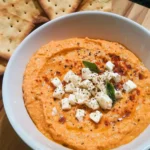In Colombia, arepas are much more than just a meal; they represent a deep cultural connection to the land and the traditions of the Colombian people. The dish is an essential part of everyday life, and every family has its own unique way of preparing them. They can be served plain, stuffed with cheese, or paired with meats, avocados, and vegetables for a more substantial meal. Arepas are not just a food; they are a celebration of Colombian history and community.
Whether you’re enjoying them as part of a family breakfast, as a savory snack, or alongside a hearty meal, Arepas de Colombia are a comforting, satisfying dish that brings people together. Perfect for Hispanic Heritage Month, they offer a flavorful introduction to the culinary traditions of Colombia and Latin America.
Full Recipe
Ingredients:
-
2 cups arepa flour (pre-cooked cornmeal)
-
2 cups warm water
-
1/2 teaspoon salt
-
1/4 cup butter
-
1/2 cup cheese (queso fresco or mozzarella)
-
1 tablespoon olive oil (for cooking)
Directions:
-
In a large bowl, combine the arepa flour and salt. Gradually add warm water and stir until a dough forms.
-
Knead the dough for about 5 minutes until smooth and pliable.
-
Divide the dough into small balls and flatten each into a round patty about 1/2-inch thick.
-
Heat the olive oil in a skillet over medium heat.
-
Cook the arepas for about 4-5 minutes on each side or until golden brown and crispy.
-
Once cooked, remove from the skillet and let them cool slightly.
-
While still warm, slice them open and stuff with cheese and butter for a creamy, savory filling.
Prep Time: 10 minutes | Cooking Time: 15 minutes | Total Time: 25 minutes
Kcal: 220 kcal | Servings: 6 servings
Discover the Flavorful and Versatile Arepas de Colombia: A Colombian Classic Perfect for Hispanic Heritage Month
Arepas de Colombia are a delicious and beloved part of Colombian cuisine, making them the perfect dish to showcase during Hispanic Heritage Month. This traditional food, made primarily of cornmeal, is simple yet packed with flavor. The versatility and cultural significance of arepas make them a standout choice in any meal plan or celebration, from breakfast to dinner or as a satisfying snack. Whether served as a savory dish with cheese, meats, or vegetables, or enjoyed on their own with butter, these crispy yet soft cornmeal cakes are a true culinary treasure.
The Origin and Cultural Significance of Arepas
Arepas have a deep-rooted history in Latin American culture, particularly in Colombia and Venezuela, with each country offering its own distinct take on this dish. In Colombia, arepas are a daily staple, found in nearly every household, restaurant, and street corner vendor. The popularity of arepas stems from their versatility and the ability to tailor them to suit different tastes and occasions. They can be enjoyed at any time of day, from a quick breakfast to a savory dinner, or even as a late-night snack.
For Colombians, the arepa holds a cultural importance beyond just its taste. It’s a symbol of heritage, a dish that has been passed down through generations. The corn that forms the base of the arepa is considered a sacred food in many indigenous cultures of the Americas, symbolizing sustenance, tradition, and community. Making arepas is often a family affair, with each member playing a role in preparing and cooking the dish. From the mixing of the dough to the frying or grilling of the arepas, this dish brings people together to share not only a meal but also a piece of history.
Arepas De Colombia: Simple Ingredients with Endless Possibilities
One of the reasons why arepas have endured for centuries is their simplicity. Made with just a few basic ingredients cornmeal, water, and salt the dough can be shaped and cooked in various ways. The texture is firm enough to hold its shape while being tender and slightly crisp on the outside. Traditionally, the arepas are fried, but they can also be grilled or baked, depending on your preference.
Though the classic Arepa de Colombia is served plain or with a touch of butter, many Colombians love to stuff them with cheese, meat, and other savory fillings. The cheese melts into the warm, golden arepa, creating a gooey, indulgent bite. Popular fillings include queso fresco, mozzarella, or even a combination of cheeses. For a more substantial meal, arepas can be stuffed with grilled meats, such as beef, chicken, or pork, as well as avocados and fresh vegetables.
Versatility: Customizing Arepas to Your Taste
One of the most exciting aspects of arepas is their ability to be customized. While the base recipe remains the same, there are endless ways to fill, top, and serve them. For example, adding ingredients like tomatoes, onions, or garlic to the dough enhances the flavor, creating a richer taste profile. Those looking to experiment with more complex flavors might consider adding spices like cumin or chili powder, or even topping them with tangy salsa or guacamole.
Arepas are also an excellent vehicle for leftover meats and veggies. Whether you have pulled pork, grilled chicken, or sautéed vegetables from a previous meal, these fillings can easily be tucked inside the arepa for a quick and delicious repurposing of ingredients. It’s a great way to reduce food waste while enjoying a fresh meal.
For vegetarians and vegans, the possibilities are endless too. Arepas can be filled with beans, roasted veggies, or plant-based cheese alternatives. In fact, the vegetarian version of arepas de Colombia, stuffed with avocado and black beans, has become incredibly popular for those seeking a meat-free option.
Perfect for Any Meal of the Day
Arepas de Colombia are wonderfully versatile in terms of meal times. In the morning, they can be served with scrambled eggs and cheese for a hearty breakfast. For lunch, they can be filled with grilled vegetables or meat for a satisfying midday meal. At dinner, they can be paired with a fresh salad, grilled chicken, or even a spicy shrimp filling to create a complete meal.
What makes arepas particularly appealing is how easy they are to prepare and serve. The simple ingredients and quick cooking process make them an excellent choice for busy weeknights, family gatherings, or a festive celebration. They are also easy to make in large batches, so whether you’re preparing a meal for yourself or a crowd, arepas can be cooked to suit your needs.
During Hispanic Heritage Month, arepas serve as the perfect example of how food can reflect the traditions and cultural practices of a region. The simple act of making arepas kneading the dough, shaping the cakes, and cooking them becomes an act of honoring Colombian heritage and celebrating Latin American culture.
Arepas as a Symbol of Heritage and Connection
Food is much more than sustenance it is a connection to history, a thread that ties people together. When making arepas, you’re not just cooking; you’re honoring a tradition that stretches back centuries. Arepas are a beautiful reflection of the diversity and richness of Latin American culture. From the use of corn, a staple food in indigenous communities, to the creative ways arepas can be filled and served, this dish has endured because of its ability to adapt and connect people from all walks of life.
Hispanic Heritage Month is an opportunity to celebrate the culinary traditions of Latin America and highlight how food plays an integral role in cultural identity. Arepas de Colombia, in their simplicity and versatility, provide the perfect way to introduce others to the flavors and traditions of this South American country. Whether you’re a seasoned chef or a beginner in the kitchen, making arepas is an accessible and rewarding experience that allows you to connect with the culinary culture of Colombia.
A Dish for Everyone: Arepas for Any Occasion
Arepas de Colombia are not just for the experienced cook they are a dish that anyone can enjoy making. The ingredients are readily available at most grocery stores, and the cooking process is straightforward, requiring no special equipment or skills. All you need is a skillet or griddle, and you’re ready to start cooking!
In addition, the wide range of fillings makes arepas adaptable for different dietary needs. Whether you’re gluten-free, vegetarian, or simply looking for a new and exciting meal, arepas offer a canvas for creativity. The fact that they can be made in advance and reheated makes them perfect for meal prep too. You can prepare a batch of arepas and fill them with your favorite ingredients, storing them for a few days to enjoy throughout the week.
Conclusion: Celebrate Hispanic Heritage with Arepas de Colombia
Arepas de Colombia are a delicious and versatile dish that celebrates the spirit of Hispanic Heritage Month. With their deep cultural significance and adaptable flavors, these cornmeal cakes have stood the test of time and continue to bring joy to generations. Whether you’re a Colombian native, someone of Latin descent, or simply someone looking to explore new flavors, arepas are a dish that will bring people together.
The next time you’re looking for a meal that’s easy to make, full of flavor, and rich in cultural history, try making arepas de Colombia. Celebrate the flavors of Colombia and the traditions of Latin America, and enjoy the deliciousness of this beloved dish!






